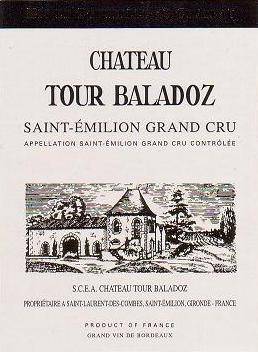
May 1950: acquisition by Emile De Schepper
A letter from Libourne dated 26 April 1950, sent by Emile De Schepper to his wife in Ghent (Belgium) tells us that the estate Château La Tour Baladoz was going to change hands the next day. The estate, located in Saint-Laurent-des-Combes, included a manor house, a vineyard worker’s house, a cellar, a vat room, quarries, and 5.56 hectares of vines.
The name “Valados” first appeared in “Le Producteur” in 1841, and was included in the first edition of “Cocks and Feret” (Bordeaux and its Wines) in 1850 under the name of “Baladoz”. From 1874 to 1922, the estate was known as Château Baladoz. Of course the name changed to Château La Tour Baladoz after a tower had been built on teh premises.
The estate is originally mentioned in a category between the 1st and 2nd Crus of Saint-Emilion, and later as a grand cru. The tenth edition of Cocks & Feret describes the château as follows:
“Remarkably well-sited, Château Tour Baladoz is located on the highest point in the region and affords visitors a superb panorama of the local countryside, including vine-covered slopes and stone walls. Entirely planted on clay-limestone soil, on a layer of bedrock, this vineyard of approximately 5 hectares features the finest premium grape varieties. It produces a very generous, aromatic, soft, extremely fine wine which has all the characteristics of a “grand premier cru”. Annual production varies from 18- 22,000 bottles.”
From 1950 to 1984
The new owner spent the first year renovating the cellars and making improvements of the vineyard. There was also a manager appointed, since Emile De Schepper could only visit the estate 3 or 4 times a year. The wine was exclusively exported in barrels to Belgium, where it was bottled in the owner’s cellars (in Ghent), since he was working in the wine business.
From 1970 onwards, Emile was assisted by his elder son Firmin who gradually took over running the estate. Firmin decided to conduct a strict quality-oriented policy, which increased the wine’s reputation.
From 1984 to the present day
The De Schepper family considered expanding the vineyard for several years. Finally, in 1984, an opportunity presented itself, and they were able to buy 3.74 hectares of vines forming an estate called “Roquettes Mondottes”. The plots were very close to Tour Baladoz so it seemed only logical to acquire them.
At that point, the estate now had about 9 hectares of vines. After Firmin’s death in 1987, his younger brother, Jacques, completed the job of combining the two estates into a single vineyard. The vat room at Tour Baladoz was enlarged and new stainless steel vats were introduced. A new manager, Jean-Michel Garcion, was appointed in 1992, and the search for quality intensified.
Rather than to feel at ease, the new team undertook particularly ambitious projects in the vineyard, convinced of Château Tour Baladoz’s bright future! Every detail mattered: after investigating why the yields had been so low until that time, priority was given to picking the grapes at just the right degree of ripeness and then carefully sorting them before they arrived at the cellar.
Fermentation in small vats made it possible to keep close track of wine from different grape varieties and different plots. The choice of barrels was based on the characteristics of each vat. Words that kept coming back throughout all these changes were rigour and quality.
In 1999, a new barrel cellar, considered to be essential to produce great wines, was built. This implied digging into solid rocks for nearly a month but the result was well worth the effort. The wine began to be aged under the best possible conditions for 12-18 months (depending on the vintage) before it was bottled at the Château.
This estate’s long history, the quality of its terroir, and the carefulness that is present in every stage of the production – from the vineyard to the bottling line – now ensured the worth and reputation of this wine.
